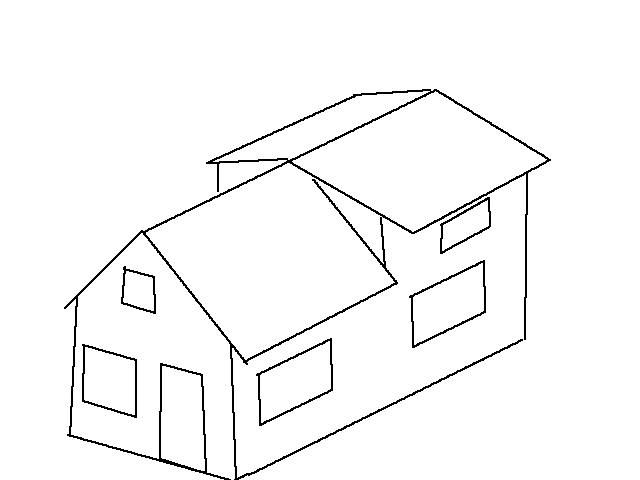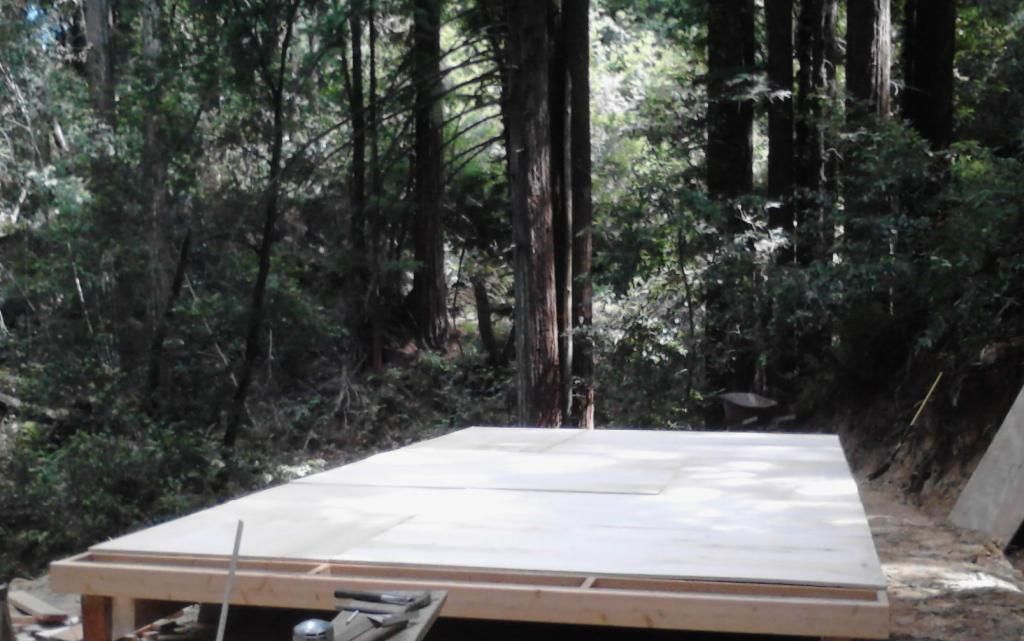| . 1 . 2 . >> |
| Author |
Message |
paulz
Member
|
# Posted: 13 Jun 2014 11:15
Reply
Is a two pitch roof like my kindergarten drawing below depicts feasible? 12x24 with the front 12 open beam ceiling living room area and back 12 bottom kitchen/bathroom and loft sleeping area above. If so, what would be the minimum roof pitch for the loft considering I get no snow. Should it be platform framed or balloon framed with a let in ledger for the loft?

|
|
bldginsp
Member
|
# Posted: 13 Jun 2014 13:11
Reply
No reason not to do different pitches on different roof portions. With no snow, you can have any pitch down to 1/8 inch per foot, but 2 in 12 inches is a minimum for effective drainage. The type of roofing you use can dictate the pitch- some types of roofing can't go below 2 in 12.
|
|
OwenChristensen
Member
|
# Posted: 13 Jun 2014 15:20
Reply
A roof like that could sag on it's own without a load. You need to hold the walls together somehow. Just a slight push outward over time will drop the peak in the middle a lot. bidginsp is right about roofing. The old three tabs were rated for 4/12, but I've seen less on moble homes.
|
|
paulz
Member
|
# Posted: 14 Jun 2014 09:44 - Edited by: paulz
Reply
The loft joists should hold the walls from spreading shouldn't they? Would I want to build it all with 8 foot walls and extend the back walls up or use longer studs in back with a let in ledger for the loft joists?
Edit: Oops, just realized the loft joists will be 6 feet below the rafters so the walls could spread above. 2x12 ridge beam?
|
|
OwenChristensen
Member
|
# Posted: 14 Jun 2014 13:26
Reply
Well you're on the right track now.
|
|
paulz
Member
|
# Posted: 14 Jun 2014 19:43
Reply
I'm thinking about a 7' ceiling height below the loft to increase space above. Bad idea?
|
|
Don_P
Member
|
# Posted: 14 Jun 2014 20:49 - Edited by: Don_P
Reply
at 12' wide with no snow load the minimum design load is 10 psf for self weight and 20 psf for wind... 30 psf. at 12' wide, rafters on 2' centers and a 4/12 pitch the design spreading force needing to be restrained is 540 lbs per rafter pair. For the front half, if the pitch is 12/12 that thrust is 180 lbs. The flatter the "toggle" the more spreading force it has.
Going to supporting the roof by hanging the rafters from a ridgebeam removes the thrust if the beam is sized correctly. If there is a post running up to support a double 2x10 ridgebeam at the pitchbreak it is quite do-able.
|
|
paulz
Member
|
# Posted: 14 Jun 2014 21:01
Reply
Thanks Don. Would I need a post from the bottom floor up or would one running from a larger front loft joist work? Would 2x6 suffice for all roof rafters on any centers?
|
|
|
Don_P
Member
|
# Posted: 14 Jun 2014 22:38
Reply
a "continuous load path" needs to be designed from ridgebeam to foundation.
The center post supporting the ridgebeam would be holding up half of the length of the ridgebeam. Each gable end would support the beam from its' gable halfway to the center port, or 1/4 of the ridgebeam load each (supported all the way to the foundation). The center post supports halfway to each gable end, or half the ridgebeam load, this is the tributary length of the load, 12'. The rafters are supported by their respective eave walls and by the ridgebeam, so each eave wall supports 1/4 of the tributary width, or 3' (plus overhang width) the ridgebeam supports half the tributary width, or 6'. So, the tributary area supported by the center post is 12' X 6', or 72 square feet X 30 pounds per square foot= 2160 lbs. If you wished to support that post in the center of a 2nd floor beam... and that is all that beam is supporting, no floor load, then the 12' center point loaded beam would need to be a built up beam of at least a triple 2x12 or a quadruple 2x10. At each end of that beam would need to be a post capable of transmitting half the beam load, or 1080 lbs each, to the foundation to complete the continuous load path in the gravity direction.
a center post running straight down to the lower floor would then need to be directly over a pier or foundation element, a simple vertical load path all the way down to a foundation element.
Yes 2x6's would be structurally adequate at up to 2' centers for this load and span. Insulation depth might require deeper rafters.
|
|
toyota_mdt_tech
Member
|
# Posted: 14 Jun 2014 23:44
Reply
Looks like big dormers is all. 
|
|
paulz
Member
|
# Posted: 16 Jun 2014 09:35
Reply
Thanks again for the advice. Question: When you attach 2x10s together to make a ridge beam (or a foundation beam for that matter), is it best to glue, bolt, screw or nail them together?
|
|
bldginsp
Member
|
# Posted: 16 Jun 2014 16:14
Reply
Nailing is probably adequate. You won't significantly increase the strength of the combined pieces by gluing or bolting, if at all. But if you are using as a beam you need to calc load and span, and have adequate footings under each end of the beam, where the supports create a concentrated point load
|
|
Don_P
Member
|
# Posted: 16 Jun 2014 20:11
Reply
Glue joints in the field count as zero, the conditions are too variable and the glues are not structural type. Although glue does not make the beam stronger, it does make it stiffer. Don't use screws for anything structural unless they are a structural screw... and they will be bragging if they are. Look for an ESR number on the box. Many small fasteners are often better than a few large ones, they distribute the load more uniformly over the piece of wood, which is not tremendously strong under the load that a large steel fastener can deliver.
Another thing that I see fairly often is folks mixing different fastener types, for instance a few nails "helped" by a bolt or two. The 2 types of fastener take load differently. Load goes to stiffness, so the entire load is first taken by the bolt and if it, or the wood around it, are incapable of resisting the load, it fails. Then the nails which need to "smear" a few thousandths before they hook up take the entire load. If there were not enough to take the entire load then they fail. Neither "helped" the other.
|
|
paulz
Member
|
# Posted: 26 Jun 2014 19:13
Reply
I'm now thinking about just a 4 in 12 roof all the way. In either case, there is this old utility pole sitting in the bushes near my house. It has a bit of a crown, maybe 4 inches. 8 inch diameter at the small end. I was thinking maybe it could be used as a ridge beam as is, anyone ever do that? Would I still need a center post halfway across the 24' span?

|
|
Don_P
Member
|
# Posted: 26 Jun 2014 21:19
Reply
It would be mighty hard to assign a strength to that 
|
|
paulz
Member
|
# Posted: 28 Jul 2014 10:18 - Edited by: paulz
Reply
Finally have most of my floor down. 12x25
Need to finalize the framing. I'm thinking 4 in 12 roof the entire length, 12' of loft and 13' of cathedral ceiling. 12' wall height, balloon frame.
Instead of a ribbon for the loft joists can I sister 8' studs to the 12' and put loft joints on top of them?
What are my options for the 12' wide by 13' long by 12' high walls of the cathedral ceiling area? Collar ties at the lower third every rafter or would I need rafter ties if not using a ridge beam? A ridge beam running the full 25' cabin length and supported by a post midway?

|
|
beachman
Member
|
# Posted: 28 Jul 2014 15:22
Reply
Paulz - you'll kill yourself trying to raise that pole as a ridgebeam - and probably anyone sleeping under it at some point in time. Just use a few good 2x10's or even 2x8's to make one. With a post in the middle and properly supported from below, you should be good to go.
|
|
Don_P
Member
|
# Posted: 28 Jul 2014 19:18
Reply
Instead of a ribbon for the loft joists can I sister 8' studs to the 12' and put loft joints on top of them?
Yes that will work fine.
What are my options for the 12' wide by 13' long by 12' high walls of the cathedral ceiling area? Collar ties at the lower third every rafter or would I need rafter ties if not using a ridge beam? A ridge beam running the full 25' cabin length and supported by a post midway?
A bit of terminology;
a collar tie is in the upper third of roof height, at least every 4' and is required to prevent uplift. As an alternative you can run metal straps over the top from the top of one rafter, over the ridge, to the top of the opposite rafter.
A rafter tie is required on every rafter pair to prevent spreading and is in the lower third of roof height. If this cannot be done then a ridgebeam is required.
The ridgebeam supports half of the roof load... well, scrolling upthread, we've been through this route already. Your utility pole would be fine for the midspan post if it's in good shape. With a ridgebeam you still need collar ties or straps over the top but you do not need rafter ties.
|
|
paulz
Member
|
# Posted: 30 Jul 2014 09:50 - Edited by: paulz
Reply
Thanks guys. Sounds like I'll go with a couple of 2x10s for a ridge beam and post in the middle. And collar ties 
|
|
razmichael
Member
|
# Posted: 30 Jul 2014 19:03
Reply
Just wondering if you have checked out if you can span the full 25ft with LVLs for the beam without a center post? Given no snow load and only 12ft wide, it may be possible??? This might avoid the need for the center post and the associated "path" to the foundation. With my cabin, partly due to the high snow load and being a bit wider at 16ft, I used 24" LVLs but supported at 16ft (but this was the front wall anyway with the remaining 8" over the covered deck under the main loft. Certainly more expensive than lumber but they were cheaper than I initially thought they would be. In addition, I liked the idea of being able to use three LVLs but less depth so I did not take up as much headroom for the loft. Also delivered with a crane truck no added cost!!
|
|
Don_P
Member
|
# Posted: 30 Jul 2014 21:29
Reply
Hmm, not a bad option, using the Georgia Pacific LVL tables the minimum size would be a double 11-7/8" LVL at about 150 lbs each. The supplier would do the actual engineering for sizing.
|
|
razmichael
Member
|
# Posted: 30 Jul 2014 22:54 - Edited by: razmichael
Reply
If I recall I used those same tables to get a rough idea and, as you say, my supply store did the validation based on their brand. I made the decision to go with 3x9.? to maintain slightly more headroom. Used Simpson hangers and metal strapping over the tops. Can't remember the hanger model number (could find it) but I do remember that They are not cheap!
|
|
paulz
Member
|
# Posted: 31 Jul 2014 22:54
Reply
That sounds great. How do I frame the end walls so support the beam? Can I use the same 12' stud height as the side walls, double plate on top, then how do I frame above the plates to the beam?
|
|
razmichael
Member
|
# Posted: 31 Jul 2014 23:19
Reply
I'm sure those with more experience can provide options but the idea is simple - carry the load to the foundation. This can be done with properly sized headers and other tricks but I went with a direct path incorporated into the framing. Picture is worth a thousand words so here is the link to my build photos and plans
Cabin Build . Likely overkill on my part but this tied everything together directly from the beam to the foundation using just a few extra 2x6 pieces. The down side to this is that you cannot have a window or door centered on the wall.
|
|
Don_P
Member
|
# Posted: 1 Aug 2014 07:13
Reply
A full height cathedral type wall should be balloon framed. The studs run from floor to roof without top plates at sidewall height that would form a weak hinge in the gable wall. This is a very common mistake that weakens the wall. The best way to support a ridgebeam is a built up post directly under it. Under the floor there needs to be a foundation element capable of bearing the load from each end of the beam. I was working on design for a 30' steel beam in a fairly large house last night, those end reactions can require careful thought, we'll be carrying 15,000 lbs down to the ground from each end of the beam. We'll definitely be bringing an engineer on board for final design.
|
|
paulz
Member
|
# Posted: 1 Aug 2014 10:27
Reply
Nice Cabin Michael, thanks for the photos.
I think I can incorporate the posts (balloon framed) directly under the beam but am planning on 2x4 walls. Will 2x4 studs sistered to the width of the beam work or do I need something thicker that will stick in past the interior wall?
|
|
Don_P
Member
|
# Posted: 2 Aug 2014 09:16
Reply
The ridgebeam is supporting half the roof width X the length, 6' x 25'= 150 sf. the load is 10psf dead load + 20 psf live load, 30 pounds per square foot. 150 sf x 30 psf= 4500 lbs. Each post is supporting half of that load, 2250 lbs.
http://www.timbertoolbox.com/Calcs/columncalc.htm
168 length
3.5 width
6
350
1.4 E
2250 P
A 4 ply 2x4 post would do it. The LVL pair is 3.5" thick. Directly under the ridgebeam make a sandwich of 2- 2x4's with a layer of 1/2" ply in the middle. On each side of that run a 2x4 up alongside the ridgebeam and nail into the faces of the LVL's creating a "saddle" to drop the ridgebeams into.
|
|
paulz
Member
|
# Posted: 4 Aug 2014 11:04
Reply
Thanks again. A friend of mine mentioned something interesting while I was boring him with my situation. He thought it would be feasible to add a post from the front of the loft up to the ridge beam (and not underneath) by using a larger (2x12 or so, maybe two) front loft joist and having that joist stick up above the loft floor so as not to compromise head room underneath (I plan to use 2x6 on 12" centers for the loft joists). Off course the side walls would have to be designed to support the load. Also one would have to step over this front joist onto the loft floor.
This would reduce the size of the required ridge beam no?
|
|
Don_P
Member
|
# Posted: 4 Aug 2014 19:43
Reply
Yes it would... but you cannot step over a tripper like that. I would not lift it more than the thickness of the subfloor, 3/4".
The center post would support half the ridgebeam with each end supporting 1/4. The loft beam would be supporting 2250 lbs as a point load at midspan. The bending moment equations are kind of interesting for a point load at midspan vs a uniformly distributed load. The same total load as a point load at midspan produces twice the bending force on a beam compared to the same total load spread out evenly along the length of a beam.
a triple 2x12, a quadruple 2x10 or a double 2x10 LVL or a triple 2x8 LVL
The ridgebeam would drop back to the double 2x10 in regular dimensional lumber.
|
|
paulz
Member
|
# Posted: 11 Aug 2014 11:13 - Edited by: paulz
Reply
For the last week I've had a friend (because I am too old and decrepit) climbing the trees above the cabin site to take down dead branches, which come off redwoods like spears. Given me time to rethink the roof for the umpteenth time. The only reason I've been stuck on a big ridge beam is for looks, but I'm starting to think rafter ties wouldn't look all that bad 12' up there. Several local builders have told me they can go on 4' centers (contrary to current codes per Don P) but even at 2' centers I think I can live with it. Anyway that is where I'm at, hope to frame some wall this week.

|
|
| . 1 . 2 . >> |

